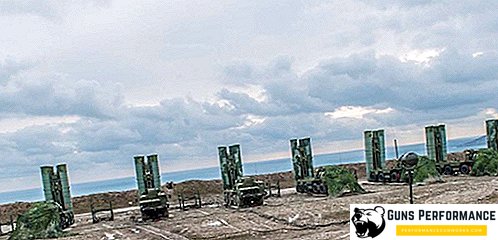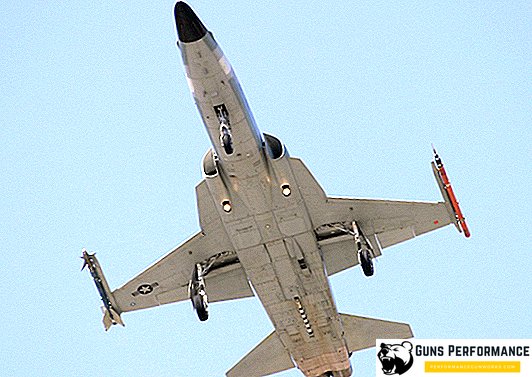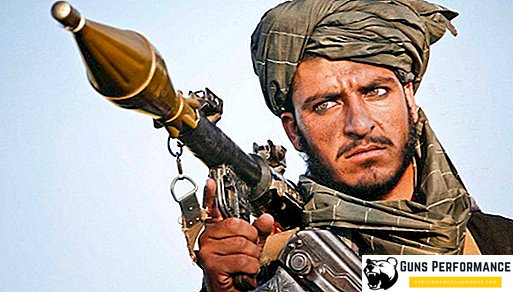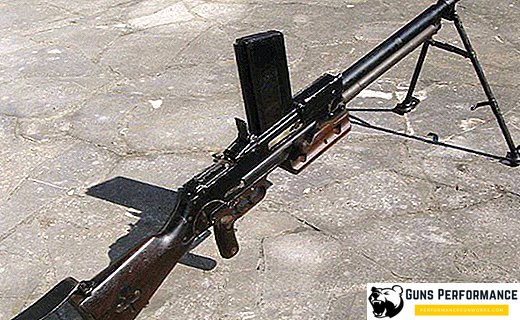It is safe to say that today the US Army is the strongest on the planet. The state, which has no probable adversary near its borders, has been able to build powerful armed forces with the most modern weapons. The number of personnel of the Army of America is just over a million soldiers (the training of which is considered a modern example for most armies of the planet), as well as almost seven hundred thousand civil servants. In the land forces they serve up to five hundred thousand people, up to two hundred thousand in the reserve army and almost four hundred and fifty thousand in the National Guard.

The US Army occupies a leading position on the planet in terms of the money spent on it. Thus, the 2016 military budget envisaged spending more than $ 607 billion on the needs of the army, which accounted for more than 34% of the total global military expenditures. According to independent sources, this is three times the defense expenditures of China and seven times the Russian ones.
General structure of the US Army
The US Army was founded in June 1775 by the decision of the Congress, it was intended to defend a young independent state. Modern American forces include separate types of aircraft:
- Ground troops;
- Air Force;
- Naval forces;
- Marine Corps (ILC);
- Coast Guard.

Moreover, all but the coast guard are directly subordinate to the Minister of Defense, the latter, in peacetime, is subordinated to the national security agency, but during the period of martial law is also subordinated to the Minister of Defense.
The US Constitution provides for the appointment of the President of the State by the Commander-in-Chief of the American Army. That, in turn, in peacetime, controls the national Armed Forces, leading the civilian minister of defense, in whose subordination are the heads of the subspecies of the Armed Forces. The heads of ministries are engaged in manning, equipping, organizing and supplying the army, as well as controlling the combat training of personnel. The highest military command of the branches of the Armed Forces are members of the Joint Chiefs of Staff. The chairman of this committee resolves issues of coordinating the activities of everything related to the military authorities of the state.
The operational submission of the US Armed Forces is reduced in the present tense to nine joint commands, five of which are formed on the basis of geographical principle.

Five combined commands:
- North American;
- South and Central American;
- European;
- Middle Eastern and Asian;
- Pacific.
In the submission of the commanders of these joint commands are all the organs of the United States Armed Forces, located in their areas of responsibility. The remaining four combined commands do not have their own areas of responsibility.
Commands include:
- Strategic command. Deals with strategic planning issues; controls strategic nuclear weapons;
- Special operations training command;
- Command training for strategic redeployment;
- Command of unified forces. Engaged in combat training in all types of aircraft.
Manning the american army
The US Army is recruited on a voluntary basis and is based on a contract basis. American citizens or permanent residents in the United States of America with residence permits who have at least a secondary education are accepted for service. The minimum candidate age for military service is 18 years. However, if you get parental approval, you can go to serve at the age of seventeen.

The age limit for the passage of active military service is determined for each type of wax of the American army. For example, the age limit may be:
- Air Force and Coast Guard - 27 years;
- Marine Corps - 28 years;
- Naval Forces - 34 years;
- Ground Forces - 42 years.
Each contractor signs a service contract for a period of four to eight years.
National-racial composition
The United States of America is a multinational state. The national composition of the country is represented, except for Europeans, by African Americans, Asians and Latin Americans. The same picture is displayed in the construction of the American army.
So, according to information from open sources, in the Armed Forces of America they serve:
- Americans of European descent - 63%;
- African Americans - 15%;
- Latinos - 10%;
- Asians - 4%;
- Indians and Native Alaskans - 2%;
- Others from mixed marriages of different - 2%;
- 4% are undecided on race or nationality.
It should be noted that the latter group includes those who do not have American citizenship, but has the right to permanent residence in the United States. Most of them go to serve in the army, because it greatly simplifies the acquisition of American citizenship.
Gender affiliation

By gender, US military personnel are divided into:
- Men - 86%;
- Women - 14%.
For many years, it was assumed that only officers could be professional military in the American army. However, after the Vietnam War, during the period of reforming the army in the early seventies, sergeant staff and military officers received the status of professional military personnel.
Mobilization resources
The total number of American population is more than 325 million people. This provides the army with extremely large mobilization resources. According to some estimates, mobresursy can be more than one hundred ten million American citizens.
Every year more than four million Americans and Americans reach military age. In addition, the state has at its disposal approximately eight hundred and fifty thousand so-called "reservists" of all combat arms. A separate branch of the armed forces is the American National Guard, formed by reserve groups created by the army and the Air Force. The total number of National Guards in the United States is approximately three hundred and fifty thousand troops.
Features of service in the US National Guard

A feature of the service in the US National Guard is the combination of service and work in civilian specialties. Each year, the National Guard accepts about sixty thousand American citizens. All of them are prescribed to undergo combat training in groups and individually. There are a total of forty-eight programs of four hours each, performed on weekends throughout the year.
In addition, the National Guards sent a camp for two weeks to participate in command-staff and military exercises in conjunction with army units. All employers are officially warned that if they try to interfere with the National Guard under the military service tasks assigned by the state, they can even be subject to criminal liability.
In addition to the patriotic feelings of Americans motivate various benefits that are provided to those serving in the US National Guard:
- Supplement to pay for accommodation;
- Supplement to pay for treatment;
- Preferential sale of goods and products in military stores;
- Refueling at military stations (at a price 50% cheaper than the market);
- Addition to the pension;
- Other

Features of the US military doctrine
Recently, the American military leadership involves the concentration of its resources in five major areas:
- The elimination of terrorism and the expansion of weapons of mass destruction;
- Intelligence service;
- Preparing for information warrants, including the protection of their informatization and communications systems, as well as the elimination of similar enemy systems;
- The struggle for military superiority in the airspace, with emphasis on the development of unmanned aircraft;
- The development of military space technology.
In this case, the American military doctrine draws attention to the preparation for military clashes in the course of non-traditional and hybrid conflicts.
US Army, Air Force and Navy Armament

Infantry weapons:
- Tanks - over eight thousand;
- Armored combat vehicles - nearly twenty six thousand;
- Self-propelled artillery guns - almost two thousand;
- Towed artillery - almost one thousand eight hundred;
- Rocket systems - more than one thousand three hundred.
Air Force:
- Aircraft - more than thirteen and a half thousand;
- Fighters - more than two thousand two hundred twenty;
- Fixed-wing combat aircraft — more than two thousand six hundred;
- Military transport aircraft - more than five thousand two hundred;
- Training aircraft - more than two and a half thousand;
- Helicopters - more than six thousand;
- Combat helicopters - more than nine hundred.
Navy:
- Total combat units - up to five hundred;
- Aircraft carriers - ten;
- Frigates - fifteen;
- Destroyers - more than sixty;
- Submarine - more than seventy;
- Coast Defense Ships - thirteen;
- Mine cruisers - thirteen.

Military units and formations
- The squad is nine to ten soldiers, these are soldiers of the US Army, commanded by a sergeant. The smallest structural element in the American army;
- The platoon (platoon) - sixteen or forty-four soldiers, led by a lieutenant. The platoon consists of two to four offices;
- The company (company) - sixty-two-hundred and ninety military personnel. It consists of three to five platoons, a company commanded by a captain;
- Battalion of the US Army (battalion) - three hundred-thousand soldiers. Consists of four to six companies, the battalion is commanded by a lieutenant colonel;
- Brigade - three to five thousand soldiers. It consists of three to five battalions headed by a colonel;
- Division (division) - ten to fifteen thousand soldiers. Its usual composition is three brigades, led by a major general;
- Corps (Corps) - two to forty-five thousand soldiers. It consists of two to five divisions; the corps is led by a lieutenant general;
- Army (army) - fifty thousand soldiers. As a rule, the army is commanded by a lieutenant general or a general with a higher rank. In its usual composition of two or more corps (one of them may be a tank).
Stripes and insignia

Chevron and stripes of the US Army are distinctive signs that are attached to clothing and reflect membership in certain structures, official position, type of troops, as well as service in a particular unit. In addition, chevrons with stripes may indicate length of service, periods of study at a military school, military or special ranks in the US Army. They can complement shoulder straps and buttonholes, or even replace them. It may also be a qualification mark, or the "US Army" mark.












